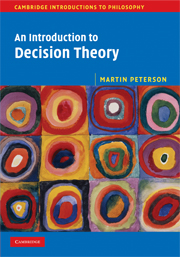Book contents
- Frontmatter
- Contents
- Preface
- 1 Introduction
- 2 The decision matrix
- 3 Decisions under ignorance
- 4 Decisions under risk
- 5 Utility
- 6 The mathematics of probability
- 7 The philosophy of probability
- 8 Why should we accept the preference axioms?
- 9 Causal vs. evidential decision theory
- 10 Bayesian vs. non-Bayesian decision theory
- 11 Game theory I: Basic concepts and zero-sum games
- 12 Game theory II: Nonzero-sum and cooperative games
- 13 Social choice theory
- 14 Overview of descriptive decision theory
- Appendix A Glossary
- Appendix B Proof of the von Neumann–Morgenstern theorem
- Further reading
- Index
8 - Why should we accept the preference axioms?
- Frontmatter
- Contents
- Preface
- 1 Introduction
- 2 The decision matrix
- 3 Decisions under ignorance
- 4 Decisions under risk
- 5 Utility
- 6 The mathematics of probability
- 7 The philosophy of probability
- 8 Why should we accept the preference axioms?
- 9 Causal vs. evidential decision theory
- 10 Bayesian vs. non-Bayesian decision theory
- 11 Game theory I: Basic concepts and zero-sum games
- 12 Game theory II: Nonzero-sum and cooperative games
- 13 Social choice theory
- 14 Overview of descriptive decision theory
- Appendix A Glossary
- Appendix B Proof of the von Neumann–Morgenstern theorem
- Further reading
- Index
Summary
Here is a simple test of how carefully you have read the preceding chapters: Did you notice that some axioms have occurred more than once, in discussions of different issues? At least three preference axioms have been mentioned in several sections, viz. the transitivity, completeness and independence axioms. Arguably, this is all good news for decision theory. The fact that the same, or almost the same, axioms occur several times indicates that the basic principles of rationality are closely interconnected. However, this also raises a very fundamental concern: Do we really have any good reasons for accepting all these axioms in the first instance? Perhaps they are all false!?
In Table 8.1 we summarise the relevant axioms by using a slightly different notation than in previous chapters. Recall that the axioms are supposed to hold for all options x, y, z, and all probabilities p such that 1 > p > 0.
A very simple standpoint – perhaps too simple – is that the preference axioms need no further justification, because we know the axioms to be true because we somehow grasp their truth immediately. However, many decision theorists deny they can immediately adjudicate whether a preference axiom is true, so it seems that some further justification is needed.
What more could one say in support of the axioms? According to an influential view, one has sufficient reason to accept a preference axiom if and only if it can somehow be pragmatically justified.
- Type
- Chapter
- Information
- An Introduction to Decision Theory , pp. 164 - 186Publisher: Cambridge University PressPrint publication year: 2009

